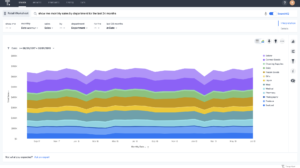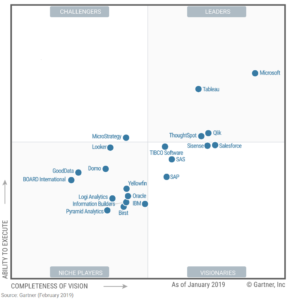
Inside ThoughtSpot’s Plan for BI World Domination

(Mikko Lemola/Shutterstock)
With $248 million more in the bank and a valuation approaching $2 billion, you could say that ThoughtSpot is having a good day. The company has had a lot of those this year, thanks to a positive Gartner review and new customer additions. But as bright as things seem today, executives at the Palo Alto, California company are preparing for much bigger achievements in the years to come.
ThoughtSpot co-founder and executive chairman Ajeet Singh wasn’t surprised when Tableau and Looker, two business intelligence (BI) software competitors, were acquired by Salesforce and Google over two successive days this June. After all, the market had started its consolidation over a decade before, when BI stalwarts BusinessObjects, Cognos, and Hyperion went to SAP, IBM, and Oracle, respectively.
“Now the second phase of consolidation is happening and it is going to clear the room for the next generation of technology to be built so that enterprises can go to the next level of productivity,” Singh tells Datanami.
“It’s been a great two months for us in so many ways,” he continues. “It is signaling to our customers that the last generation of innovation is now reaching its plateau of productivity and these companies are being acquired by larger organizations to augment their revenue streams. But in terms of fundamental innovation, in terms of pushing the world forward by a decade or two, I think that the world is ready.”
Can ThoughtSpot be the company to lead the BI industry in the next phase of innovation? “We strongly believe so,” Singh says. And with $248 million in the bank and a valuation of $1.95 billion, who’s going to tell the founders they’re wrong?
Of course, it will be the market, not venture capitalists, who decide which BI vendor leads the rest. If ThoughtSpot is going to win, it’s going to get there by executing on its plan to enable a new class of users to consume data analytics on a self-serve basis.
The problem with the previous generation of BI tools is that they require analysts to build the reports and dashboards that end-users demand, Singh says. But when you consider how many new consumers of data there are and how many skilled analysts, it becomes clear that that approach doesn’t scale, he says.
“The previous generations of tools were focused on analysts as primary users,” he says. “We are looking to have the business user ask their own questions, get value from data, and make decisions themselves without creating pressure on the analytics team. For every analyst out there, there are 600 business users. You cannot hire enough analysts to meet the hunger that the business now has for data.”
ThoughtSpot has sought to make its user interface as simple and easy to use as possible. That’s a nod to the Spartan look of Google UIs (the company’s engineering team is composed of ex-Googlers) as well as a reflection that search was the primary way to get started with the product (it has since added machine learning capabilities with SpotIQ to spot trends and anomalies).
But the simple look on the surface belies a more complex distributed underbelly that ThoughtSpot engineers took years to build to ensure that it can scale to address customers big data challenges.
“On the surface, we look like a search engine, but under the hull, we have a very a massive number-crunching machine,” Singh says. “That allows us to work with some of the largest enterprises in the world that have very large scale data, very complex data, and still be able to offer that very simple user experience on the surface.”
Simplicity is simply a business requirement if you’re going to expand your potential user base by multiple orders of magnitude and ask relatively non-technical folks to fetch their own data. It’s all about feeding the best analytics content to the highest number of people as quickly as possible.
“In a world where traditional enterprises have to compete digitally and engage in digital warfare with the modern companies, the digital natives so to speak, you cannot run your business and win by looking at daily or weekly dashboards that have been built by analysts,” Singh says. “You need to truly put the power of data and insights in the hands of your front-line business people. You need to empower your sales people, your marketing people, your doctors, your nurses, your insurance agents to be able to get value from data themselves. That’s been our thesis and that’s what we’ve been working towards.”
The company has designs on building a full analytics platform. And the company is close to that. According to Gartner’s Magic Quadrant for Analytics and Business Intelligence Platforms, released in February, the company moved up from the Visionaries Quadrant into the Leader’s Quadrant, which it shares with Qlik, Tableau, and Microsoft, “thanks to strong execution, high customer satisfaction scores, and rapid innovation.”
Gartner analysts were impressed with how ThoguhtSpot enables complex queries to be run fairly easily. It also lauded plans for integrating with R and DataRobot to extend data science capabilities. But it also signaled caution on a couple of fronts, including a lack of rich graphs, the lack of a large partner network, and the absence of vertical industry capabilities.
These are issues that the company will likely address with the new round of funding. According to Singh, the growth-stage funding will help the company fill out following a period of rapid expansion in preparation for an IPO.
“It’s our goal to build a large independent company. An IPO obviously is a very critical milestone along the way,” he says. “If you look at the evaluation, if you look at the dollar amount, it’s effectively an IPO. But it gives us more runway to build out the company more, build the team more globally, build more predictably in the business, operational readiness and those kinds of things at a larger scale, and then be able to take the company public.”
Related Items:
Seizing Business Opportunities at the Speed of Thought
ThoughtSpot Eyes Exit with Latest Funding Round
Rethinking Enterprise Search for the Big Data Age
































